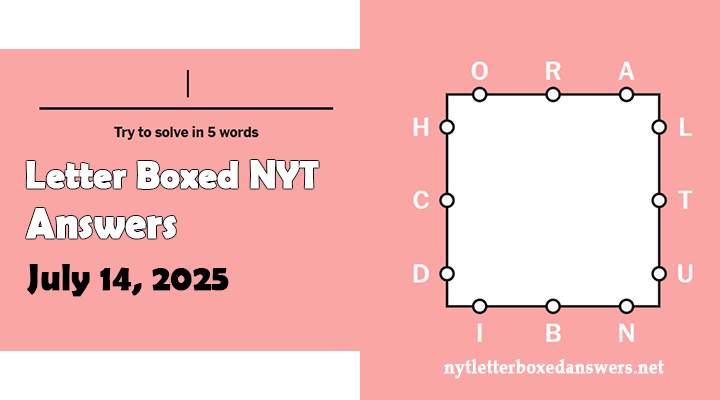NYT Letter Boxed quiz for Monday July 14, 2025 is released. We came up with Letter Boxed July 14 2025 Answers and Hints for you. With the help of these hints, you will be able to guess the words of letter boxed quiz without revealing the answers and get the solution.
| Top | Right | Bottom | Left |
|---|---|---|---|
| ORA | LTU | IBN | HCD |
| Two Words Solution | ||
|---|---|---|
| AURIC | CLOTHBOUND | |
| CLOTHBOUND | DIACRITIC | |
| CLOTHBOUND | DIACRITICAL | |
| CLOTHBOUND | DIURNAL | |
| Three Words Solution | ||
|---|---|---|
| ABC | CITRIC | CLOTHBOUND |
| ABC | COURT | THAILAND |

Word 01:
This 5-letter word starts with A and ends with C; relating to gold or containing gold.
Common in inorganic chemistry to denote gold compounds.
Derived from Latin aurum, meaning gold.
Seen in terms like “auric chloride.”
Indicates gold in the +3 oxidation state.
Opposite of “aurous” which represents gold in +1 state.
Symbolically linked with wealth or royalty.
Used in metallurgy and elemental naming.
Appears in chemical equations involving gold.
Can describe golden color or quality in poetic usage.
Word 02:
This 10-letter word starts with C and ends with D; describes a book bound in cloth rather than paper or leather.
Typical of hardcover books with durable fabric covers.
Offers sturdiness and an elegant texture.
Preferred for special editions and library copies.
Often includes embossing or gold leaf on the spine.
Considered more premium than paperback.
Common in classic literature reprints.
Associated with high-quality publishing.
Helps protect pages and add aesthetic value.
Sometimes includes a dust jacket or slipcase.
Word 01:
This 10-letter word starts with C and ends with D; describes a book bound in cloth rather than paper or leather.
Typical of hardcover books with durable fabric covers.
Offers sturdiness and an elegant texture.
Preferred for special editions and library copies.
Often includes embossing or gold leaf on the spine.
Considered more premium than paperback.
Common in classic literature reprints.
Associated with high-quality publishing.
Helps protect pages and add aesthetic value.
Sometimes includes a dust jacket or slipcase.
Word 02:
This 9-letter word starts with D and ends with C; a mark added to a letter to indicate a different pronunciation.
Found in many languages including French, Arabic, and Vietnamese.
Includes accents, tildes, cedillas, and umlauts.
Helps distinguish homographs and tones.
Common in phonetic alphabets and linguistic studies.
Essential in dictionaries and transliterations.
Also called diacritical marks or signs.
Not used in standard English spelling.
Latin and Greek roots mean “to distinguish.”
Alters sound, stress, or intonation of letters.
Word 01:
This 10-letter word starts with C and ends with D; describes a book bound in cloth rather than paper or leather.
Typical of hardcover books with durable fabric covers.
Offers sturdiness and an elegant texture.
Preferred for special editions and library copies.
Often includes embossing or gold leaf on the spine.
Considered more premium than paperback.
Common in classic literature reprints.
Associated with high-quality publishing.
Helps protect pages and add aesthetic value.
Sometimes includes a dust jacket or slipcase.
Word 02:
This 11-letter word starts with D and ends with L; relating to or constituting a diacritic or distinguishing mark.
Describes the nature of special signs in scripts.
Used in linguistic description and orthography.
Often refers to small marks above or below letters.
Modifies pronunciation or meaning of characters.
Helps clarify ambiguous spellings.
Appears in academic writing on phonology.
Strongly tied to foreign language spelling systems.
Can influence how letters are visually encoded.
Extends the basic Latin alphabet’s expressive range.
Word 01:
This 10-letter word starts with C and ends with D; describes a book bound in cloth rather than paper or leather.
Typical of hardcover books with durable fabric covers.
Offers sturdiness and an elegant texture.
Preferred for special editions and library copies.
Often includes embossing or gold leaf on the spine.
Considered more premium than paperback.
Common in classic literature reprints.
Associated with high-quality publishing.
Helps protect pages and add aesthetic value.
Sometimes includes a dust jacket or slipcase.
Word 02:
This 7-letter word starts with D and ends with L; active during the daytime rather than at night.
Opposite of nocturnal.
Common in animal behavior and sleep studies.
Describes human natural rhythms and sleep cycles.
Seen in ecology and circadian biology.
May refer to plants that bloom in daylight.
Rooted in Latin dies meaning day.
Appears in scientific and poetic writing alike.
Used to describe solar patterns or routines.
Helps classify species based on their time of activity.
Word 01:
This 3-letter word starts with A and ends with C; the first three letters of the English alphabet, often used to represent the basics.
Synonymous with fundamentals or building blocks.
Used in teaching children how to read and write.
Appears in idioms like “learning your ABCs.”
Can refer to alphabetical order.
Used metaphorically for basic skills in any field.
Appears in educational songs and rhymes.
Common in phonics and literacy instruction.
Symbolic of foundational knowledge.
Can also refer to the American Broadcasting Company.
Word 02:
This 6-letter word starts with C and ends with C; relating to or derived from citrus fruit.
Most often seen in the phrase “citric acid.”
Found naturally in lemons, limes, and oranges.
Used as a preservative and flavor enhancer.
Vital in cellular metabolism via the citric acid cycle.
Appears in food labels and ingredient lists.
Slightly sour or tangy in taste.
Important in biochemistry and nutrition.
Derived from Latin citrus.
Involved in chelating metals and cleaning.
Word 03:
This 10-letter word starts with C and ends with D; describes a book bound in cloth rather than paper or leather.
Typical of hardcover books with durable fabric covers.
Offers sturdiness and an elegant texture.
Preferred for special editions and library copies.
Often includes embossing or gold leaf on the spine.
Considered more premium than paperback.
Common in classic literature reprints.
Associated with high-quality publishing.
Helps protect pages and add aesthetic value.
Sometimes includes a dust jacket or slipcase.
Word 01:
This 3-letter word starts with A and ends with C; the first three letters of the English alphabet, often used to represent the basics.
Synonymous with fundamentals or building blocks.
Used in teaching children how to read and write.
Appears in idioms like “learning your ABCs.”
Can refer to alphabetical order.
Used metaphorically for basic skills in any field.
Appears in educational songs and rhymes.
Common in phonics and literacy instruction.
Symbolic of foundational knowledge.
Can also refer to the American Broadcasting Company.
Word 02:
This 5-letter word starts with C and ends with T; a place where legal cases are heard and decided.
May refer to judicial, sports, or royal settings.
Includes judges, juries, and lawyers.
Found in phrases like “go to court” or “court of law.”
In sports, it’s where games like tennis or basketball are played.
Historically refers to royal or noble assemblies.
Can mean to pursue romantically.
Associated with legal systems and governance.
May include trial, appeal, or supreme versions.
A place where disputes are settled officially.
Word 03:
This 8-letter word starts with T and ends with D; a Southeast Asian country known for its beaches, temples, and cuisine.
Capital city is Bangkok.
Formerly known as Siam.
Famous for floating markets and elephant sanctuaries.
Known for spicy food and tropical climate.
Borders Myanmar, Laos, Cambodia, and Malaysia.
Uses the Thai baht as currency.
Has never been colonized by a European power.
Rich in Buddhist culture and architecture.
Popular tourist destination for natural and cultural diversity.

Chris Brown is a passionate word game love and problem solving expert. With over 15 years of experience in solving puzzle challenges, he provides daily NYT Letter Boxed answers, tips and strategies to help other players so that they can improve their solving skills. Whether you are stuck on a tricky puzzle or looking for new techniques, Chris is here to guide you with his expert solutions.